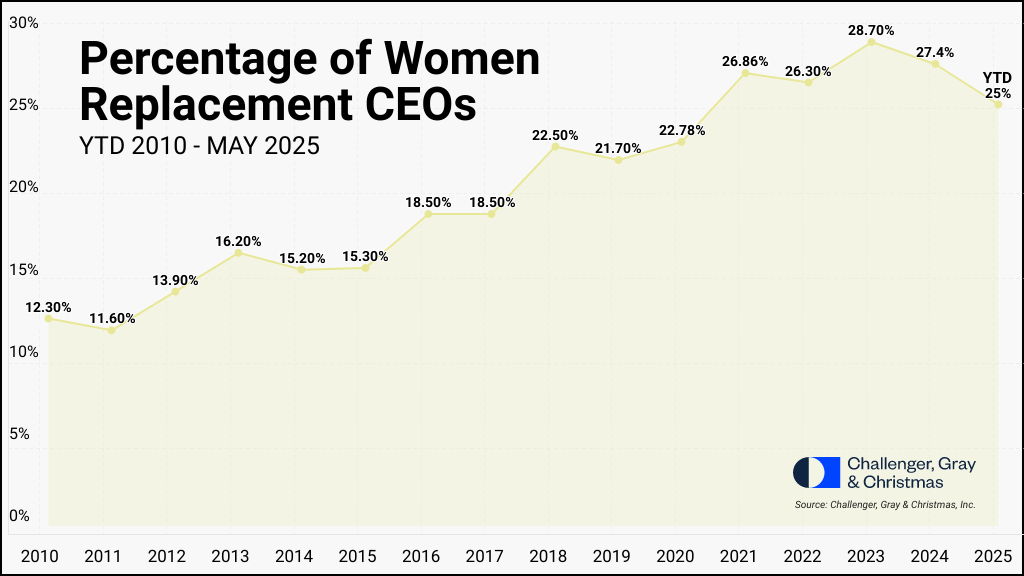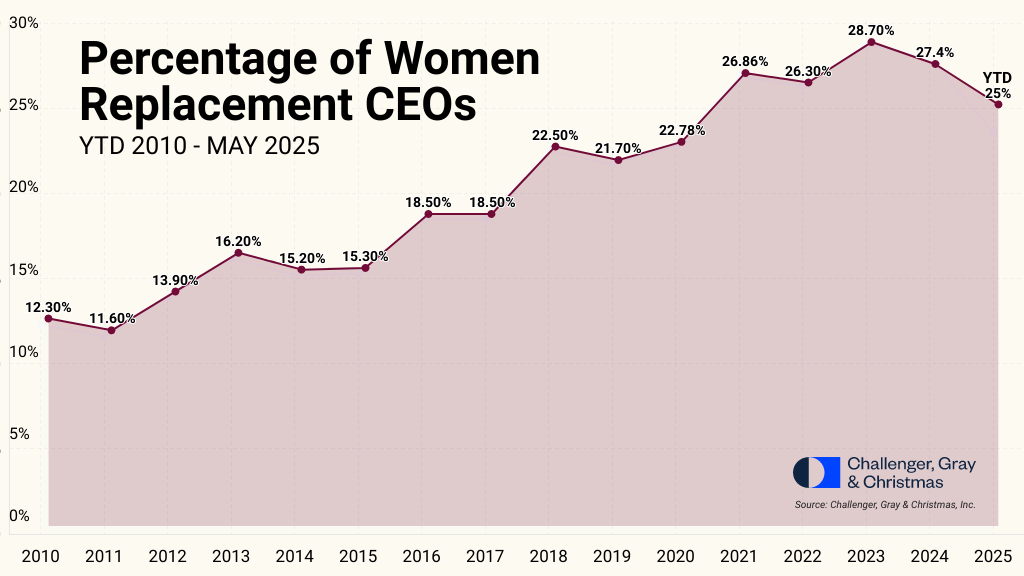
Jul 09 Women Leadership Crisis: Fewer Women Rise to CEO Role in 2025, Pay Gap Remains
Texas Women’s Foundation Executive Leadership Accelerator Partners with Challenger, Gray & Christmas to Drive Meaningful, Systemic Support of Women Leaders
Published July 9, 2025
Just one quarter of rising CEOs are women in 2025, down from nearly 30% during the same period last year. Meanwhile, the rate of women leaving the CEO role is higher in 2025 than during the same time last year, and men are replacing them more often, according to data from global outplacement and executive coaching firm Challenger, Gray & Christmas (CGC).
Against this backdrop, the Texas Women’s Foundation (TXWF), a leading organization that advances economic and leadership opportunities for Texas women and girls, announces the launch of its Executive Leadership Accelerator (ELA)—a bespoke leadership experience designed exclusively for senior-level executive women preparing for partner or C-suite roles. In partnership with CGC, who will design and deliver the program, the Foundation seeks to drive meaningful, systemic change for women leaders and the organizations they serve.
“It is imperative for organizations to support women leaders and position them for success in executive roles. The loss of women leaders does not only negatively impact employee recruitment and retention efforts, it also limits diverse perspectives around the tables where key decisions are made, hinders collaboration and innovation, and ultimately weakens long-term organizational performance,” said Karen Hughes White, president and CEO of TXWF.
Through the first quarter of 2025, 23% of CEOs who left their positions were women, compared to 20% last year. Of the women who have left their posts, 56% of those women were replaced by men, up from 41% in 2024. Of the 497 men who left their roles so far in 2025, 17% of them were replaced by women, down from 22% in 2024.
In Texas specifically, despite comprising 44% of the workforce, women occupy only for 28% of top executive, according to Texas Women’s Foundation’s 2024 Economic Issues for Women in Texas Report. In addition, according to the organization’s recent white paper, Texas Women and the Wage Gap, women in Texas earn 83% of what their male counterparts earn, resulting in $60 billion in lost earnings and spending in Texas each year. Over her lifetime, the average Texas woman loses $750,000 dollars in lifetime earnings due to the wage gap.
“Preparing women for leadership roles does not only benefit the individual; it supports families, companies, and entire communities,” added Hughes White.
HIRING PLANS IN 2025
Through June 2025, U.S. employers have announced 82,932 planned hires, a 19% increase over the 69,920 announced at this point in 2024. While this represents growth, hiring activity remains historically low, particularly when compared to the surge in hiring during the post-pandemic recovery years.
“Hiring announcements are up from last year, which is encouraging. Employers are hiring more cautiously in 2025, likely in response to economic uncertainty and continued cost pressures,” said Challenger.
Those interested in applying should meet these criteria:
- Senior-level leaders with 15+ years of experience in for-profit Texas organizations who are preparing for partner or C-suite roles.
- Executives currently leading business units or strategic initiatives with significant P&L responsibilities; and
- Experienced leaders identified as “ready now” or “ready next” for key leadership roles.
Applications will be accepted now through August 25. The program will kick off in October and run through May 2026. For more information and to apply, visit www.txwf.org/executiveleadershipaccelerator or email leadership@txwf.org.
Virtual information sessions to discuss the program will be held on the following days:
Thursday, July 10th at 12:00 p.m. (Central)
Wednesday, August 13 at 12:00 p.m. (Central)
Register here: https://www.txwf.co/events/2025-ela-info-session
The program is designed and delivered by Challenger, Gray & Christmas in partnership with Texas Women’s Foundation. This strong collaboration highlights the Foundation’s continued commitment to accelerating women’s leadership and advancing equity across Texas.
About Texas Women’s Foundation:
Texas Women’s Foundation (TXWF) raises funds from a broad base of donors, including individuals, foundations and corporations. These resources support nearly $6 million in investments each year that advance economic security and leadership for Texas women and girls through research, advocacy, grantmaking and leadership programs. Since its inception in 1985, TXWF has invested nearly $85 million in Texas women and girls. As the organization prepares to celebrate its 40th year, the need to build #StrongWomenBetterTexas has never been more critical.
The Foundation’s statewide research on the issues impacting Texas women and girls provides corporate, state and local decision-makers and lawmakers with critical data to inform policies, practices and programs across the state. Its advocacy, grantmaking and leadership programs support solutions that help Texas women and girls survive and thrive. In addition, Texas Women’s Foundation is an acknowledged leader and advocate in the impact investing movement, deploying 100 percent of its invested assets – endowments, operating investments and donor-advised funds – in a portfolio that yields strong financial returns and social benefits to women and girls. For more information, visit www.txwf.org, Facebook, X, LinkedIn or Instagram or donate.
About Challenger, Gray & Christmas
Challenger, Gray & Christmas is the premier global outplacement and executive coaching firm, providing expert guidance to organizations and individuals navigating career transitions. With a history spanning more than 50 years, Challenger partners with companies of all sizes and industries to deliver customized workforce solutions that support employee success. Our executive coaching services help leaders enhance their effectiveness, develop critical skills, and drive business performance. Rooted in authenticity, empathy, and a commitment to doing the right thing, Challenger empowers organizations to foster resilient, high-performing teams. For more information, visit www.challengergray.com.


